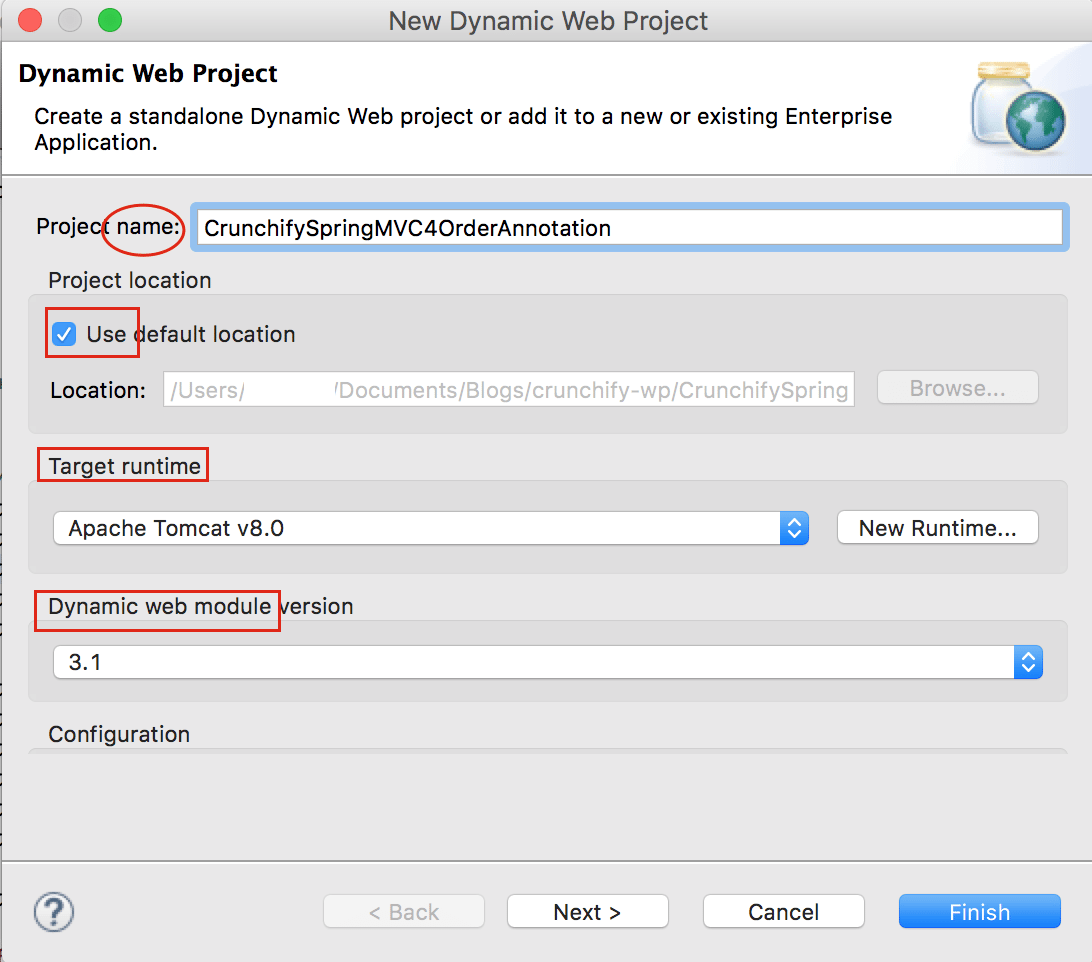Web MVC framework – Spring is the best web controller framework and configuration model for Java based programming enterprise application.
We do have more than 40 Spring MVC tutorials on Crunchify so far. In this tutorial we will go over @Order Annotation. What is the use of @Order in spring? Ordering aspects with Spring AOP & MVC.
Here are the short steps:
- We are going to create Dynamic Web Project
- Create Spring Config file
crunchify-bean.xml - Convert it to Maven Project
- Create Beans with Order Annotation
- Create test-case and execute
Detailed Steps: Let’s get started
Step-1
- Go to Eclipse
- Click on
File - Click on
New - Click on
Dynamic Web Project
Step-2
- Provide Project name:
CrunchifySpringMVC4OrderAnnotation - Provide Target runtime. Mainly Apache Tomcat location in Eclipse.
- Choose Dynamic Web Module version:
3.1
Step-3
- Right click on project
- Click on Configure
- Convert project to Maven project
Step-4
Choose default setting and click Finish.
Step-5
Here is a project structure before we start.
Open pom.xml file and add Spring MVC 4.3.4 dependency.
<dependency> <groupId>org.springframework</groupId> <artifactId>spring-context</artifactId> <version>4.3.4.RELEASE</version> </dependency>
here is my complete pom.xml file
<project xmlns="http://maven.apache.org/POM/4.0.0" xmlns:xsi="http://www.w3.org/2001/XMLSchema-instance" xsi:schemaLocation="http://maven.apache.org/POM/4.0.0 http://maven.apache.org/xsd/maven-4.0.0.xsd">
<modelVersion>4.0.0</modelVersion>
<groupId>CrunchifySpringMVC4OrderAnnotation</groupId>
<artifactId>CrunchifySpringMVC4OrderAnnotation</artifactId>
<version>0.0.1-SNAPSHOT</version>
<packaging>war</packaging>
<build>
<sourceDirectory>src</sourceDirectory>
<plugins>
<plugin>
<artifactId>maven-compiler-plugin</artifactId>
<version>3.3</version>
<configuration>
<source>1.8</source>
<target>1.8</target>
</configuration>
</plugin>
<plugin>
<artifactId>maven-war-plugin</artifactId>
<version>2.6</version>
<configuration>
<warSourceDirectory>WebContent</warSourceDirectory>
<failOnMissingWebXml>false</failOnMissingWebXml>
</configuration>
</plugin>
</plugins>
</build>
<dependencies>
<dependency>
<groupId>org.springframework</groupId>
<artifactId>spring-context</artifactId>
<version>4.3.4.RELEASE</version>
</dependency>
</dependencies>
</project>
Step-6
- Right click on Java Resources
- Click on New
- Click on Source Folder and provide name:
resources
Step-7
Create file crunchify-bean.xml file under resource folder. Here is a complete file content.
<?xml version="1.0" encoding="UTF-8"?> <beans xmlns="http://www.springframework.org/schema/beans" xmlns:xsi="http://www.w3.org/2001/XMLSchema-instance" xmlns:p="http://www.springframework.org/schema/p" xmlns:context="http://www.springframework.org/schema/context" xsi:schemaLocation="http://www.springframework.org/schema/beans http://www.springframework.org/schema/beans/spring-beans-4.0.xsd http://www.springframework.org/schema/context http://www.springframework.org/schema/context/spring-context-4.0.xsd"> <context:annotation-config /> <!-- Specify Bean ID "orders" --> <bean id="orders" class="com.crunchify.spring.tutorials.CrunchifyPrintResult" /> <!-- This is required and loads each class under below package --> <context:component-scan base-package="com.crunchify.spring.tutorials" /> </beans>
Step-8
Now we will create 5 files with @Order annotation.
- CrunchifyCompany.java Interface
- CrunchifyGoogle1.java ==> With
@Order(1) - CrunchifyFacebook2.java ==> With
@Order(2) - CrunchifyYahoo3.java ==> With
@Order(3) - CrunchifyPrintResult.java
CrunchifyCompany.java
package com.crunchify.spring.tutorials;
/**
* @author Crunchify.com
*
*/
public interface CrunchifyCompany {
// do nothing here
}
CrunchifyGoogle1.java
package com.crunchify.spring.tutorials;
import org.springframework.core.annotation.Order;
import org.springframework.stereotype.Component;
/**
* @author Crunchify.com
*
*/
@Component
@Order(1) // @Order defines the sort order for an annotated component. The value() is optional and represents an order value as
// defined in the Ordered interface. Lower values have higher priority. The default value is
// Ordered.LOWEST_PRECEDENCE, indicating lowest priority (losing to any other specified order value).
public class CrunchifyGoogle1 implements CrunchifyCompany {
private String order = "Crunchify Google with Order-1";
public String toString() {
return "Class Name: " + this.getClass().getSimpleName() + " - Result: " + this.order;
}
}
CrunchifyFacebook2.java
package com.crunchify.spring.tutorials;
import org.springframework.core.annotation.Order;
import org.springframework.stereotype.Component;
@Component
@Order(2)
public class CrunchifyFacebook2 implements CrunchifyCompany {
private String order = "Crunchify Facebook with Order-2";
public String toString() {
return "Class Name: " + this.getClass().getSimpleName() + " - Result: " + this.order;
}
}
CrunchifyYahoo3.java
package com.crunchify.spring.tutorials;
import org.springframework.core.annotation.Order;
import org.springframework.stereotype.Component;
@Component
@Order(3)
public class CrunchifyYahoo3 implements CrunchifyCompany {
private String order = "Crunchify Yahoo with Order-3";
public String toString() {
return "Class Name: " + this.getClass().getSimpleName() + " - Result: " + this.order;
}
}
CrunchifyPrintResult.java
package com.crunchify.spring.tutorials;
import java.util.List;
import org.springframework.beans.factory.annotation.Autowired;
import org.springframework.stereotype.Component;
/**
* @author Crunchify.com
*
*/
@Component
public class CrunchifyPrintResult {
@Autowired
private List<CrunchifyCompany> order;
private String result = "";
public String toString() {
order.stream().forEach((temp) -> {
this.result = result + temp + "\n"; // print result and add new line
});
return this.result;
}
}
Step-9
Now let’s create testcase CrunchifyOrderTest.java
package com.crunchify.spring.tests;
import org.springframework.context.ApplicationContext;
import org.springframework.context.support.ClassPathXmlApplicationContext;
import com.crunchify.spring.tutorials.CrunchifyPrintResult;
/**
* @author Crunchify.com
*
*/
public class CrunchifyOrderTest {
@SuppressWarnings("resource")
public static void main(String[] args) {
// Load Spring ApplicationContext file crunchify-beans.xml
ApplicationContext context = new ClassPathXmlApplicationContext("crunchify-beans.xml");
// get the bean which we specified in file crunchify-beans.xml file
CrunchifyPrintResult results = (CrunchifyPrintResult) context.getBean("orders");
// After loading each class - just print result
System.out.println(results);
}
}
Step-10
Now just right click on file CrunchifyOrderTest.java and Run As -> Java Application. You should see result printed in the order which we specified Order.
Class Name: CrunchifyGoogle1 - Result: Crunchify Google with Order-1 Class Name: CrunchifyFacebook2 - Result: Crunchify Facebook with Order-2 Class Name: CrunchifyYahoo3 - Result: Crunchify Yahoo with Order-3








